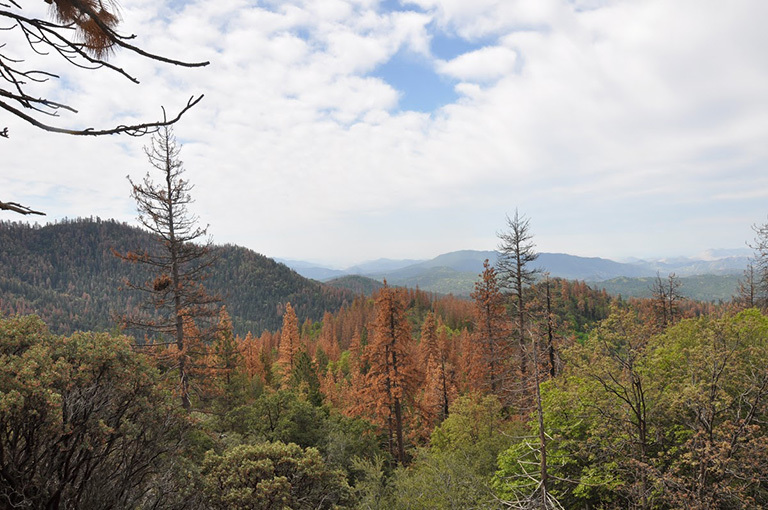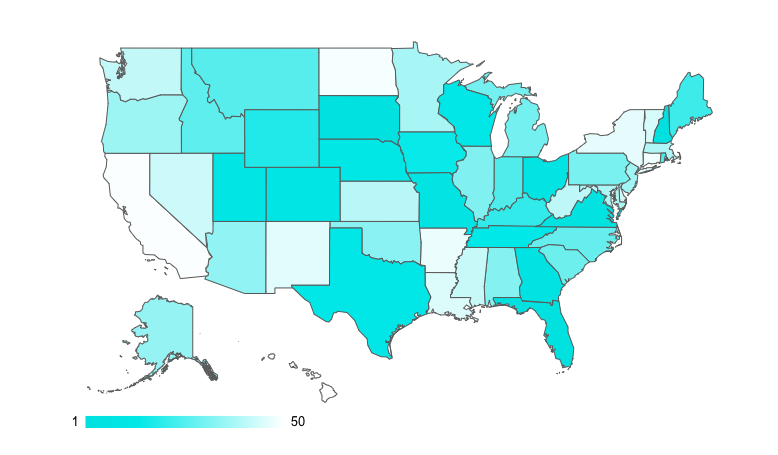
NASA maps California drought effects on Sierra trees. (Photo: climate.nasa.gov)
New Study Finds California Unlikely To Meet Some 2030 Environmental Goals
Greenhouse gas reduction benchmark to hit 40% below 1990 levels will not be met until 2047
By Evan Symon, March 15, 2024 12:19 pm
According to a new study by environmental non-profit group Next 10, California is not going to meet their goal of reducing greenhouse gases in the state by 40% where they were in the 1990’s by 2030, with it showing that, at the current rate of decarbonization, that goal won’t be met until around 2047.
Since the mid-2000’s, California has put up numerous benchmarks and goals for reducing pollution and greenhouse gases in California. While many goals have been set decades ahead, such as reaching 100% renewable power production by 2045, others were put into place much sooner. In fact, in many cases, California’s goals were already being reached naturally by affected industries but with regulations still being put into place by the state.
However, in other cases, it was more unrealistic. In 2006, AB 32 was signed into law, stating that California is to have greenhouse gas levels at least 40% below 1990 levels by 2020, then moved out to 2030. While this was applauded by environmental groups, other groups were shocked by just how unrealistic that goal was considering the growing needs for energy in California and multiple other factors. The demand nearly became even more impossible in 2022 when Governor Gavin Newsom proposed that that 40% should be bumped up to 55% by 2030 to help kickstart more green projects in the state. While that didn’t go through, the 40% figure loomed large, with the state appearing farther and farther away from reaching it as the years passed.
This led to Next 10’s report on Thursday. While the group did find that greenhouse gases are dropping overall, they are nowhere close to where they are needed to meet the 2030 goal. In fact, thanks to the shuffling around during the COVID-19 pandemic, greenhouse gases actually went up in California in 2021.
Currently, California has, on average, a reduction of greenhouse gases by 1.5% each year. However, in an analysis of California Air Resources Board (CARB) data, a reduction of 4.6% is needed each year to reach the 2030 goal, with that figure likely to be even higher once 2023 data is fully collected. Based on current data, California would not reach the 40% goal by at least 2047 under the current reduction levels.
“The increase in emissions following the pandemic makes it all the more difficult for California to meet its climate goals on time,” said F. Noel Perry, Founder of Next 10, on Thursday. “In fact, we may be further behind than many people realize. If you look at the trajectory since 2010, California won’t meet our 2030 climate goal until 2047. We need to triple the rate of decarbonization progress each year to hit that target.
“While California is well-positioned as a leader on climate, there are substantial obstacles to accelerating our decarbonization efforts in an equitable way that benefits all Californians. These are not insurmountable, but we need to act urgently in order to achieve these goals on time.”
Greenhouse gas 40% reduction from 1990 levels goal off by at least 17 years
In-state power generation was cited by the study as a particular example for a reason for the rise, with emissions from increasing significantly by 10.3% between 2019 and 2021. Experts noted that renewable sources would be needed to not only help hit the 2030 goal, but other emissions goals as well
“While California is moving in the right direction in many ways, renewable electricity generation must greatly increase in the coming years in order to reach the state’s goal,” the study said. “To meet our upcoming target of 50% of electricity from renewable sources by 2026, we need to double the speed we are adding renewables to our power mix, from 4.3% per year to 8.7% per year.”
While the report did notice some successes, such as significant reductions in auto emissions and a growing electric vehicle market, those advances have been offset by the gains in the power generation and industrial sectors.
“This study is pretty indicative that California’s climate policies are not as good as they are leading everyone to think,” LA-based energy expert Adam Klein told the Globe on Friday. “They’re doing pretty well on some things on just pure statistics of it, but others, not so much. They really set goals way to strict.”
“They need to give companies and industries time to figure out ways to adjust and so forth. Now with cars, they’re naturally going more electric anyway, so California is benefitting from that. And even there there is some cooling in the market right now. But other places, you know, it is taking awhile. Especially with energy concerns in California and many regulations staying in place to benefit the California economy. So that 2030 goal for knocking down greenhouse gases? That was never going to fly. Even if California buckles down on it all, we’ll still come nowhere near that. They’re giving 2047 as a date, and California should evaluate if they can make it by 2040 instead. Maybe 2045.”
“Whoever we have as Governor in 2030, they’re going to face a lot of uncomfortable questions over goals not being met. That’s for sure.”
More California environmental policy benchmark reports are expected to be out soon.
- San Diego Country Supervisor Jim Desmond Calls San Diego New Epicenter Of Illegal Crossings By Migrants - April 27, 2024
- Oracle Moving Headquarters Out Of Austin Only 4 Years After Moving Out Of California - April 26, 2024
- Congressman Adam Schiff Robbed of his Luggage in San Francisco Car Break In - April 26, 2024





Well, no DUH…
100% of these “goals” are rooted in political motives, wrapped up in feel-good, environmental virtue-signaling, but ultimately done for political power consolidation, with some financial kickbacks. thrown in for good measure…
What’s Newsom’ s arrangement with CCP affiliate BYD, the do-everything conglomerate that manufactures everything from personal protective equipment for their C19 plandemic to electric buses and vehicles….
What’s the payoff, Gav???
Breaks my heart. All these goals are rooted in causing harm to the people of this state. I paraphrase Rush- “I hope they fail”.
California Democrat’s phony climate policies come directly from their WEF globalist and CCP masters and the payoffs they receive to impose them?
And, our Democrat “Sister State” of Colorado (aka “East California”) at least has some voices that are willing to stand up to the green-weenies who wish to crash the economy for their “existential threat” mitigation policies :
““It’s horrible on every front because it claims to be about CO2 emission reduction, which it’s not,” said CSI Energy Fellow Trisha Curtis. “It’s beyond detrimental and devastating to the economic state of Colorado and it really doesn’t appreciate the economic realities at all….
Curtis added: “It frankly seems like it’s written by people who have zero understanding of basic energy use, transportation, or economics.”
Link to full article :
https://gazette.com/news/environment/stopping-oil-drilling-would-be-an-economic-catastrophe/article_a2d20936-9377-5559-a072-3cd684e5ccc5.html
Related article, to show the concerted effort being pushed by the Democrat cabal :
https://gazette.com/news/environment/colorado-legislator-proposes-new-oil-drilling-ban-by-2030/article_51aa3620-6ebe-5b3a-8ddf-fec265ff0c10.html